
The 'Empty' Church Revisited
Seiten
2017
Routledge (Verlag)
978-1-138-45661-7 (ISBN)
Routledge (Verlag)
978-1-138-45661-7 (ISBN)
"The Empty Church Revisited" presents a systematic account of British churchgoing patterns since the 19th century, uncovering the factors and the statistics behind the considerable process of decline in church attendance.
When did churches start to appear more empty than full - and why? The very physicality of largely empty churches and chapels in Britain plays a powerful role in popular perceptions of 'religion'. Empty churches are frequently cited in the media as evidence of large scale religious decline. The 'Empty' Church Revisited presents a systematic account of British churchgoing patterns over the last two hundred years, uncovering the factors and the statistics behind the considerable process of decline in church attendence. Dispelling as myth the commonly held views that the process of secularization in British culture has led to the decline in churchgoing and resulted in the predominantly empty churches of today, Gill points to physical factors, economics and issues of social space to shed new light on the origins of empty churches. This thoroughly updated edition of Robin Gill's earlier work, The Myth of the Empty Church, presents new data throughout to explore afresh the paradox of church building activity in a context of decline, the patterns of urbanisation followed by sub-urbanisation affecting churches, changes in patterns of worship, and changes within the sociology of religion in the last decade.
When did churches start to appear more empty than full - and why? The very physicality of largely empty churches and chapels in Britain plays a powerful role in popular perceptions of 'religion'. Empty churches are frequently cited in the media as evidence of large scale religious decline. The 'Empty' Church Revisited presents a systematic account of British churchgoing patterns over the last two hundred years, uncovering the factors and the statistics behind the considerable process of decline in church attendence. Dispelling as myth the commonly held views that the process of secularization in British culture has led to the decline in churchgoing and resulted in the predominantly empty churches of today, Gill points to physical factors, economics and issues of social space to shed new light on the origins of empty churches. This thoroughly updated edition of Robin Gill's earlier work, The Myth of the Empty Church, presents new data throughout to explore afresh the paradox of church building activity in a context of decline, the patterns of urbanisation followed by sub-urbanisation affecting churches, changes in patterns of worship, and changes within the sociology of religion in the last decade.
Robin Gill, University of Kent at Canterbury, UK
Contents: Preface; Introduction; The data; Rural churchgoing decline; Glan-Ilyn: a rural case study; Urban churchgoing decline; General increase: 1821 to 1851; Free Church increase and Anglican decline: 1851 to the 1880s; General decline: 1880s to 1919; Continuing decline: 1920s to 2000; York: an urban case study; The future of the churches; Tables; Index.
| Erscheinungsdatum | 07.08.2017 |
|---|---|
| Reihe/Serie | Explorations in Practical, Pastoral and Empirical Theology |
| Verlagsort | London |
| Sprache | englisch |
| Maße | 156 x 234 mm |
| Gewicht | 521 g |
| Themenwelt | Religion / Theologie ► Christentum ► Kirchengeschichte |
| Sozialwissenschaften ► Soziologie ► Spezielle Soziologien | |
| ISBN-10 | 1-138-45661-6 / 1138456616 |
| ISBN-13 | 978-1-138-45661-7 / 9781138456617 |
| Zustand | Neuware |
| Haben Sie eine Frage zum Produkt? |
Mehr entdecken
aus dem Bereich
aus dem Bereich
von Athanasius bis Gregor dem Großen
Buch | Softcover (2024)
C.H.Beck (Verlag)
CHF 18,90
eine Geschichte der christlichen Kunst
Buch | Hardcover (2024)
C.H.Beck (Verlag)
CHF 44,75


